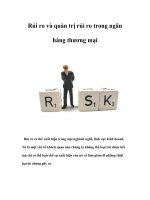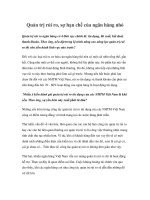CH18 quản trị rủi ro value at risk
Bạn đang xem bản rút gọn của tài liệu. Xem và tải ngay bản đầy đủ của tài liệu tại đây (714.68 KB, 41 trang )
Chapter 19
Value at Risk
The Question Being Asked in VaR
“What loss level is such that we are X%
confident it will not be exceeded in N
business days?”
VaR and Regulatory Capital
(Business Snapshot 18.1, page 436)
Regulators base the capital they require
banks to keep on VaR
The market-risk capital is k times the 10-
day 99% VaR where k is at least 3.0
VaR vs. C-VaR
(See Figures 18.1 and 18.2)
VaR is the loss level that will not be
exceeded with a specified probability
C-VaR (or expected shortfall) is the
expected loss given that the loss is greater
than the VaR level
Although C-VaR is theoretically more
appealing, it is not widely used
Advantages of VaR
It captures an important aspect of risk
in a single number
It is easy to understand
It asks the simple question: “How bad can
things get?”
Time Horizon
Instead of calculating the 10-day, 99% VaR
directly analysts usually calculate a 1-day 99%
VaR and assume
This is exactly true when portfolio changes on
successive days come from independent
identically distributed normal distributions
day VaR1-day VaR-10
×=
10
Historical Simulation
(See Tables 18.1 and 18.2, page 438-439))
Create a database of the daily movements in all
market variables.
The first simulation trial assumes that the
percentage changes in all market variables are
as on the first day
The second simulation trial assumes that the
percentage changes in all market variables are
as on the second day
and so on
Historical Simulation continued
Suppose we use m days of historical data
Let vi be the value of a variable on day i
There are m-1 simulation trials
The ith trial assumes that the value of the
market variable tomorrow (i.e., on day m+1) is
1
−
i
i
m
v
v
v
The Model-Building Approach
The main alternative to historical simulation is to
make assumptions about the probability
distributions of return on the market variables
and calculate the probability distribution of the
change in the value of the portfolio analytically
This is known as the model building approach or
the variance-covariance approach
Daily Volatilities
In option pricing we measure volatility “per
year”
In VaR calculations we measure volatility
“per day”
252
y ear
day
σ
=σ
Daily Volatility continued
Strictly speaking we should define σday as
the standard deviation of the continuously
compounded return in one day
In practice we assume that it is the
standard deviation of the percentage
change in one day
Microsoft Example (page 440)
We have a position worth $10 million in
Microsoft shares
The volatility of Microsoft is 2% per day
(about 32% per year)
We use N=10 and X=99
Microsoft Example continued
The standard deviation of the change in
the portfolio in 1 day is $200,000
The standard deviation of the change in
10 days is
200 000 10 456, $632,
=
Microsoft Example continued
We assume that the expected change in
the value of the portfolio is zero (This is
OK for short time periods)
We assume that the change in the value
of the portfolio is normally distributed
Since N(–2.33)=0.01, the VaR is
2 33 632 456 473 621. , $1, ,
× =
AT&T Example (page 441)
Consider a position of $5 million in AT&T
The daily volatility of AT&T is 1% (approx
16% per year)
The S.D per 10 days is
The VaR is
50 000 10 144, $158,
=
158 114 2 33 405, . $368,
× =
Portfolio
Now consider a portfolio consisting of both
Microsoft and AT&T
Suppose that the correlation between the
returns is 0.3
S.D. of Portfolio
A standard result in statistics states that
In this case σX = 200,000 and σY = 50,000
and ρ = 0.3. The standard deviation of the
change in the portfolio value in one day is
therefore 220,227
Y
XYXYX
σρσ+σ+σ=σ
+
2
22
VaR for Portfolio
The 10-day 99% VaR for the portfolio is
The benefits of diversification are
(1,473,621+368,405)–1,622,657=$219,369
What is the incremental effect of the AT&T
holding on VaR?
657,622,1$33.210220,227
=××
The Linear Model
We assume
The daily change in the value of a portfolio
is linearly related to the daily returns from
market variables
The returns from the market variables are
normally distributed
The General Linear Model
continued (equations 18.1 and 18.2)
deviation standard sportfolio' theis and
variableofy volatilit theis where
2
1
222
1 1
2
1
P
i
n
i
ijjiji
ji
iiP
n
i
n
j
ijjijiP
n
i
ii
i
xP
σ
σ
ρσσαασασ
ρσσαασ
α
∑ ∑
∑∑
∑
= <
= =
=
+=
=
∆=∆
Handling Interest Rates: Cash
Flow Mapping
We choose as market variables bond
prices with standard maturities (1mth,
3mth, 6mth, 1yr, 2yr, 5yr, 7yr, 10yr, 30yr)
Suppose that the 5yr rate is 6% and the
7yr rate is 7% and we will receive a cash
flow of $10,000 in 6.5 years.
The volatilities per day of the 5yr and 7yr
bonds are 0.50% and 0.58% respectively
Example continued
We interpolate between the 5yr rate of 6%
and the 7yr rate of 7% to get a 6.5yr rate
of 6.75%
The PV of the $10,000 cash flow is
540,6
0675.1
000,10
5.6
=
Example continued
We interpolate between the 0.5% volatility
for the 5yr bond price and the 0.58%
volatility for the 7yr bond price to get
0.56% as the volatility for the 6.5yr bond
We allocate α of the PV to the 5yr bond
and (1- α) of the PV to the 7yr bond
Example continued
Suppose that the correlation between
movement in the 5yr and 7yr bond prices
is 0.6
To match variances
This gives α=0.074
)1(58.05.06.02)1(58.05.056.0
22222
α−α××××+α−+α=
Example continued
The value of 6,540 received in 6.5
years
in 5 years and by
in 7 years.
This cash flow mapping preserves
value and variance
484$074.0540,6
=×
056,6$926.0540,6
=×









